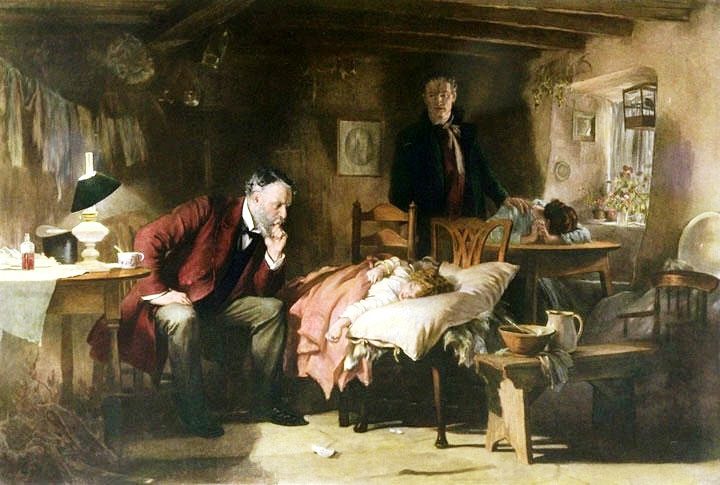“The good physician knows his patient through and through, and his knowledge is bought dearly. Time, sympathy, and understanding must be lavishly dispensed, but the reward is to be found in that personal bond which forms the greatest satisfaction of the practice of medicine. One of the essential qualities of the clinician is his interest in humanity, for the secret of the care of the patient is in caring for the patient.”

Sir Luke Fildes
Dr. Francis W. Peabody was still a young man when he wrote one of the great classics of American medicine, The Care of the Patient. He knew he was suffering of malignant disease at the time when he gave his address to the Harvard graduating class on October 21, 1926, and he died one year later at age 47.
Addressing what he perceived to be the medicine’s major problems of his time, his article reads as if it had been written today. Education is too precious a thing to be left to the teachers, he commences his address, for left solely in their hands it would soon stagnate or deteriorate. The system, in his view, produces doctors competent in the sciences, who know a great deal about the mechanism of disease but very little about the practice of medicine—this written at a time when not even sulfonamides, let alone penicillin, had been discovered. Medicine, he argued, is not a trade to be learned but a profession to be entered, and one cannot expect to become a skillful practitioner in the few years allotted to medical school.
Importantly, he wrote, medicine is by excellence a personal affair between physician and patient. It is art grafted on a scientific background but something truly private, to take place in the doctor’s office and not in the dehumanizing atmosphere of the hospital wards or outpatient clinics, where Henry Jones becomes an interesting case of mitral stenosis rather than a laborer lying awake nights while he worries about feeding his wife and six children. Indeed the description of the 1927 hospital is the same as that of 2013, with rushed interns and residents, ephemeral attendings, patients treated by the system but not by an individual doctor whom they can trust.
It is in this context, suggests Dr. Peabody, that lies the opportunity for the medical student. For he only has time, to sit down by the bedside and learn all about the patient assigned to him, to get to know him as a human being, perhaps to learn that he is not someone who “has nothing the matter with him” but whose symptoms, so-called functional, emanate from difficult circumstances occurring in this individual’s life. “Disease in man is never exactly the same as disease in an experimental animal, for in man the disease at once affects and is affected by what we call the emotional life. Thus, the physician who attempts to take care of a patient while he neglects this factor is as unscientific as the investigator who neglects to control all the conditions that may affect his experiment.” He needs to know his patient through and through, for, as has been quoted so many times in what soon will be a century, “the secret of the care of the patient is in caring for the patient.”
References
- Peabody, F. W. The Care of the Patient. JAMA 1927; 88:877-882.
- Rabin, P. L. and D. Rabin. The Care of the Patient. Francis Peabody Revisited. JAMA 1984; 252:819-820.

Leave a Reply